Simulating Warfare in No Video Game
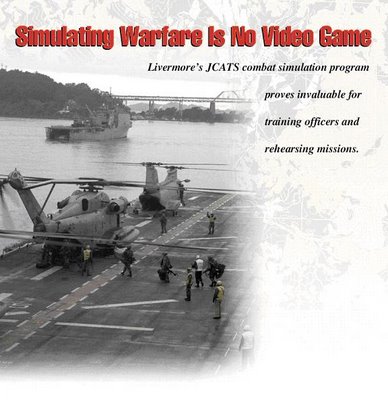
WITH whirling helicopters, grinding tanks, and screaming soldiers, computer war games have become some of the most popular software programs for video arcades and personal computers in recent years. Long before computers became a household item, however, the nation's armed forces were taking advantage of computer-driven combat simulations to train officers, rehearse missions, and explore tactics.
Since the mid-1970s, Lawrence Livermore computer scientists, working at the Conflict Simulation Laboratory, have pioneered increasingly realistic software for the Department of Defense. The Laboratory's landmark Janus program, developed in the late 1970s, was the first conflict simulation to use a graphical user interface. Since then, Livermore experts have remained at the forefront of combat simulation development by taking advantage of steady advances in hardware and software and by working closely with military officers to understand their needs.
By all accounts, the Livermore simulations have proved highly valuable to the military. They have been employed in Operation Just Cause in Panama and Operation Desert Storm in the Mideast, as well as for combat planning in Somalia, Bosnia, and other international trouble spots.
In 1997, a team of computer scientists from the Laboratory's Nonproliferation, Arms Control, and International Security (NAI) Directorate unveiled Livermore's most powerful combat program. JCATS (Joint Conflict and Tactical Simulation) merged and upgraded the capabilities of two earlier programs, the Joint Conflict Model, an advanced version of Janus, and the Joint Tactical Simulation, an urban conflict model. (See S&TR, November 1996, pp. 4-11). Significantly, the program also incorporated important new features requested by its DoD sponsor, the Joint Warfighting Center in Fort Monroe, Virginia, that conferred greater fidelity to the simulations.
JCATS was used to rehearse possible combat options in support of the 1999 Kosovo conflict. It was also used by the Marine Corps and the Navy to plan for and participate in an exercise in the San Francisco Bay Area. During the exercise, JCATS tracked the live participants and tested in real time the effects of virtual air and artillery attacks on the participants.
Taking Physics into Account
Livermore computer scientist Faith Shimamoto, JCATS project leader, notes that every aspect of the program takes physics into account. Typical computer games may look impressive with flashy three-dimensional effects, she says, but they don't always observe the laws of physics.
A typical PC game soldier can jump off a 15-meter cliff without a scratch, but a soldier in JCATS doing the same thing will be badly injured. Neither do commercial games take into account such seemingly mundane but crucial factors as fatigue, inclement weather, low food supplies, or poor visibility. "JCATS realistically simulates the capabilities and limitations of armaments, people, and the environment," she says.
Tom McGrann, deputy leader of the tactical systems section in the Laboratory's Conflict Simulation Laboratory, notes that JCATS is a direct descendant of Janus, building on more than two decades of computer-driven mission analysis and rehearsal experience. "We want to help DoD with software that gives commanders a realistic, cost-effective, and operator-friendly training tool," he says. "Our programs give officers a detailed feel for how combat operations will go, from the deployment of an aircraft carrier to an individual soldier."
The program is currently used for training both individuals and command staffs in tactics and deployment of resources, analyzing the effectiveness of weapons and different force structures, and planning and rehearsing missions. Besides warfighting scenarios, JCATS can also simulate exercises for drug interdiction, disaster relief, peacekeeping, counterterrorism, hostage rescue, and site security. Current users include the Army, Air Force Security Forces, Special Operations Command, Marine Corps, Naval Post Graduate School, U.S. Southern Command, U.S. Army Europe, Department of Energy, and Secret Service.
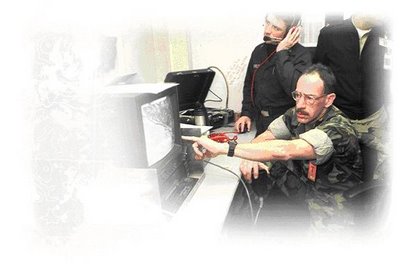
Program Controls 60,000 Elements
An enhanced version of JCATS released in October 1999 can simulate up to 60,000 individual elements, from soldiers to planes to mob participants. What's more, the new version can run on a workstation as well as on a laptop computer, making it feasible for use in the field.
The new program typically simulates a battle between two opposing sides (often called red and blue forces), but it can accommodate up to 10 sides with friendly, enemy, and neutral relationships. Depending on the rules of engagement established for the conflict, a soldier can be programmed to shoot at the first sign of an opposing force, hide, dig a foxhole, fire only upon positive identification, or take other action. The rules of engagement may change during the simulation as political alliances shift or when civilians become involved.
Players see only their respective forces and whatever intelligence they acquire about opposing forces by visual or auditory means, including forward scouts, spotter planes, radar, and sensors. A large hill, for example, can prevent a soldier from visually spotting enemy forces massing on the other side. Tanks generate noise that can be "heard" by nearby opposing forces.
Typically, a controller at a master workstation has a bird's-eye view and can observe the movement of forces on all sides. To test players' responses to the unexpected, the controller can resurrect fallen troops, change the weather, provide more fuel, speed up the clock, release a biological weapon, and the like.
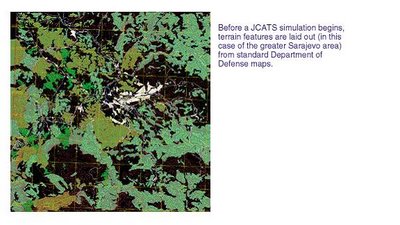
Games Can Last Weeks
The duration of games varies from 20 minutes for a brief site security exercise involving a few people to two weeks for a complex drug interdiction rehearsal involving different agencies. Sometimes a short game is run dozens of times so that statistical sampling can be used to evaluate a particular tactic or weapon system.
Setting up a JCATS exercise takes one to two weeks depending on the number and kinds of combat forces and, especially, the kinds of topography to be modeled. Terrain is modeled with extraordinary fidelity. Rivers, for example, can be characterized by their current, depth, and underwater obstacles. Players can enter terrain data, including correct elevation and geographical features, from standard DoD maps of the world (such as the one below at the left) and from DoD digitized terrain data.
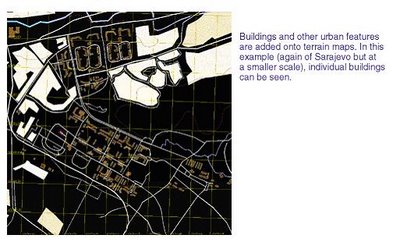
Players can also import blueprints of specific buildings (below) for urban warfare and site security exercises. Or users can create their own town or building, as is often done for drug interdiction training. In these cases, JCATS offers a palette of menus to create everything from windows and doors to streets and parks.
Shimamoto points out that terrain significantly affects movement of troops, aircraft, tanks, and maritime operations. A rescue helicopter cannot safely land in a forest, amphibious landing craft must negotiate rocky shores, vehicles move slowly through swamps, and soldiers slow considerably when marching uphill. Environmental factors such as adverse weather, nightfall, and smoke from combat also affect mobility.
JCATS is unusually flexible in the sheer scale of battle, from the defense of a nation involving thousands of soldiers, planes, ships, and vehicles, to the rescue of a hostage in an underground compound by a handful of special operations personnel. Typically, the maximum simulation area, or playbox, is 660 by 660 kilometers, but it can be expanded under special conditions. Even at this enormous scale, a player can zoom in on a city to view details such as roads, rivers, and buildings, and then select an individual building and examine its floor plans.
Depending on the exercise, players have at their disposal a vast range of weapons, including tracked and wheeled vehicles, aircraft and helicopters, ships and submarines, and even systems that are in the development or conceptual stage. Infantry soldiers may have machine guns, rifles, antitank weapons, mortars, and other munitions. Nonlethal weapons, increasingly important as the military assumes peacekeeping duties around the world, include rubber bullets, clubs, tear gas, pepper spray, stinger grenades, rocks, foam, and fists.
Simulations Strengthen Livermore Site Security
The realism of JCATS simulations in urban settings makes it extremely valuable for assessing and strengthening site security at a range of government facilities, including the very institution that created the program. For the past several months, security managers at Lawrence Livermore have been using JCATS to test established interdiction measures against a variety of adversary scenarios. The work has helped to sharpen security strategies, identify vulnerabilities, and train officers for different kinds of threats, even those deemed highly improbable.
Livermore security managers have conducted more than 200 exercises with JCATS, with each exercise repeated about 10 times. According to Stuart Jossey, security administrator with Livermore's Safeguards and Security Department, most of the scenarios involve attempts to gain entry to the Laboratory's heavily guarded Superblock area that houses special nuclear material. Jossey says that JCATS is invaluable for simulating the close-combat, interior fighting conditions a real incursion might involve.
Currently, a small corps of people including Special Response Team members, Protective Force supervisors, and security administrators participate in JCATS exercises at Livermore. The department's long-range goal is to integrate JCATS into the development of site security tactics and training. Operator proficiency requires between two and three weeks of training. "The scenarios involve a lot of mouse clicks under pressure," Jossey notes.
The exercises are performed at adjoining computer stations by operators controlling a designated number of virtual security personnel driving in patrol cars or patrolling on foot. The operators wear headphones to communicate with each other about what their forces see and hear. Their computer screens display buildings comprising the Superblock area and adjoining facilities as well as the location and health of people under their command.
In a nearby room, another operator controls a number of "bad guys" intent, for example, on breaking into a facility containing special nuclear material. This monitor shows only the intruders and any Lawrence Livermore security members they detect. Jossey, meanwhile, operates a station that depicts the locations of all the participants. He can change the makeup of each opposing force, as well as their weapons, on the fly.
Jossey says the simulations are a powerful supplement to real drills involving players with laser-tag-like weapons that are staged regularly in and around the Superblock area. "It's expensive doing actual exercises," he says. "We also run a safety risk because many of our exercises are done at night with people running on roofs, climbing fences, and responding tactically in patrol cars." JCATS allows the department to test security strategies to help decide what scenarios the actual exercises should focus on.
The completed simulations are saved on disk and then replayed for the participants on a large-screen monitor. Jossey invites comments from participants about the exercise, especially how things might have gone better. He also uses the program's Analyst Workstation feature to obtain statistical data such as casualties and ammunition used.
"We get a lot of good statistical information," he says. "The whole point is to make sure we have designed a strategy that denies unauthorized entry to our critical facilities."
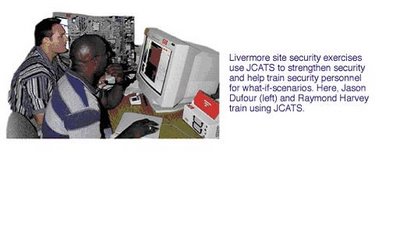
Model's Power Is in the Details
Military operations include clearing barriers; aircraft takeoff and landing; bombing runs; naval gunfire; building foxholes, vehicle holes, and fortifications; sandbagging; looking around, standing, and crouching; recovering weapons and ammunitions; resupplying food, fuel, and ammunition; and mounting onto or dismounting from vehicles, ships, airplanes, and helicopters.
With a feature unique to JCATS, a player may aggregate entities (soldiers, tanks, or other individual units) into a group such as a formation, convoy, squad, or battalion that is then viewed and controlled as one icon. In this way, large formations are more easily viewed and controlled while the program tracks and records activity at the individual entity level. At any moment, a player can zoom in on a squad and examine events involving just a few soldiers, each uniquely outfitted and trained.
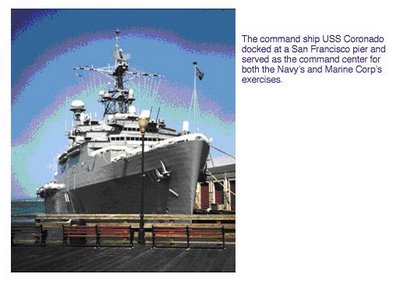
The effectiveness of every weapon, from a laser-guided missile to a single bullet, is determined by probability-of-hit and probability-of-kill statistics compiled by DoD. Using these data, JCATS calculates, for example, the blast area and resulting casualties from tripping a land mine. Just as easily, the program calculates if a launched antitank weapon misses the tank, destroys it, incapacitates the tank's movement but leaves its gun free to fire, or destroys the gun but leaves the tank's mobility intact.
Virtual soldiers face hazards from fatigue, enemy and friendly fire, poor health, and inadequate training. Every soldier begins with a certain amount of energy, which is expended more quickly during running or walking uphill. Players can bring in medical assets to attend to the sick or wounded.
In recognition of possible modern enemy capabilities, JCATS can simulate the release of chemical or biological warfare agents as well as other substances that might by employed as poisons during acts of terrorism or warfare. For example, the program can display how exposure to an atmospheric release of a nerve agent can affect personnel. Such capabilities make it useful for developing both military and civilian preparedness and responses.
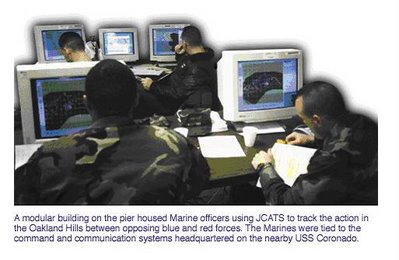
Many Options to Review a Game
Players can choose from several options to review a completed game. The entire exercise can be replayed at different speeds. The Analyst Workstation, a feature that conducts rapid analyses of exercise data, can also be employed. This capability is especially useful, says Shimamoto, because in combat simulation, only a small fraction of the data is important to any specific factor under scrutiny.
One of JCATS's most significant enhancements is modeling the urban environment for such missions as hostage rescue, disaster relief, mob control, or protecting heads of state along a motor route. In urban settings, players can view groups of buildings as well as individual building floors and their features-including glass and solid walls, windows, doors, and stairwells-roofs, and underground features, such as tunnels, sewers, and garages. Virtual forces fighting inside buildings are hampered by limited lines of sight, poor lighting, and the risk of injury to civilians.
The program's superb urban simulation capabilities led the U.S. Navy and Marine Corps to give JCATS an important role in exercises conducted last March in the San Francisco Bay Area. The Marine Corps exercise was dubbed Urban Warrior Advanced Warfighting Experiment. Its objective was to develop and test new concepts, tactics, and technologies to prepare Marines for combat in the next century, especially activities in urban areas. The Navy's companion exercise, Fleet Battle Experiment-Echo, also took advantage of JCATS. (See S&TR, June 1999, pp. 4-11.)
The exercises were run from the Navy command ship USS Coronado, which was docked at a pier in San Francisco. A small building inside the pier housed Marines running JCATS terminals and other command and communications systems. All data were fed to the command ship. Livermore computer scientist Mike Uzelac, director of operations for JCATS, monitored the exercise from the building.
According to McGrann, the Marines focused on an urban exercise because its studies show that by 2020, about 70 percent of the world's population will live in cities and at least 80 percent of those cities will be located within 300 miles of the coastline. Fighting in urban areas, says McGrann, is particularly treacherous because of the danger to the civilian population and because of the numerous hiding places for opponents.
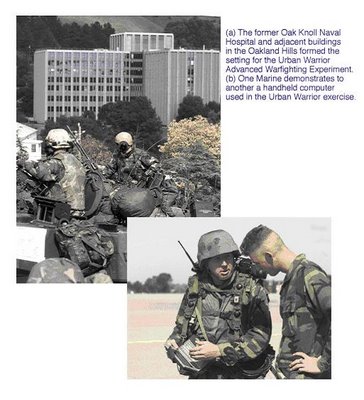
Enemies Eye Urban Warfare
A recent statement by Col. Mark Thiffault, Director, Joint Information Bureau, Urban Warrior, underscores the Marines' commitment to winning urban battles: "Our enemies, having watched Desert Storm on CNN, know they cannot engage the United States with conventional methods. These potential foes view cities as a way to limit the technological advantages of our military. They know that cities, with their narrow streets, confusing layout and large number of civilian noncombatants, place limits on our technological superiority and especially our use of firepower. We have to develop technologies that allow us to win while minimizing collateral damage."
McGrann says that the Marines are concerned about the performance degradation that occurs in standard command, control, communications, computer, and intelligence systems because of cities' concrete buildings, phone lines, and other electronic devices. As a result, Urban Warrior Marines experimented with wireless communications devices, satellite links, remotely piloted reconnaissance aircraft, and global positioning system links.
The focus of the exercise was an intense battle between some 700 battle-dressed Marines, divided into red and blue forces, at the former Oak Knoll Naval Hospital in the Oakland Hills. Both sides wore Multiple Integrated Laser Engagement System gear similar to that used in laser-tag games. Red forces, holed up in the hospital, barricaded stairwells with anything they could find as they tried to fight off blue forces intent on taking over the building.
The fierce battle was set against a backdrop of civil unrest taking place in more than 30 small, adjoining buildings. In this outlying area, additional blue forces kept order among noisy reporters, milling civilians, and rock-throwing agitators, all played by paid actors. (Actual video footage of the exercise can be viewed on the Marine Corps's Urban Warrior Web page at www.defenselink.mil/special/urbanwarrior/.)
Prior to the exercise, Marine Corps personnel, who had previously trained on JCATS, modeled the interiors of the buildings (including the hospital's 9 stories and 500 rooms) by digitizing construction blueprints and entering the data into the program's "terrain editor." The Marines' Integrated Global Positioning System Radio System provided updates every 30 seconds on the position of vehicles and soldiers outside buildings. Because the radio system is ineffective inside buildings, every hospital room was wired with the Inside Building Instrumentation System to keep track of each Marine's location and health status (healthy, wounded, or killed) when they were inside.
The ever-changing data on the Marines' locations were broadcast from the Oakland Hills on secure communication links and fed into JCATS for viewing on screen. In this way, command personnel on the pier and aboard the USS Coronado were provided unprecedented, real-time details about the location of their Oakland forces, including the whereabouts of combatants on every floor of the hospital.

Virtual Strikes Complete Exercise
JCATS also simulated the effects of artillery and tactical air strikes that obviously could not be used in the Oakland area. Computer-generated weapons even included systems that currently exist only in concept. The virtual strikes were executed by a Marine JCATS operator in San Francisco, acting on request by an officer at the battle and approved by an operation commander.
The program calculated the time of flight and the effects based on the impact of the virtual strike and the reported location of the live participants. In this way, commanders learned within seconds the effects of using these weapons. Back in Oakland, both red and blue participants were quickly informed through their laser tag and radio gear if they had been wounded or killed by the virtual strikes.
While the battle for control of the hospital raged, JCATS simulated combat on Treasure Island in San Francisco Bay and on the San Francisco-Oakland Bay Bridge. Red forces driving toward Oakland were attacked by blue virtual aircraft. Simulated Navy ships just off the coast were also included in the overall conflict.
Following the exercise, the program provided a thorough review for the command officers. The review showed who was killed and how and when they became casualties, thereby removing much of the uncertainty that often surrounds the lessons-learned process following an exercise.

Uzelac says that the Marines were pleased with the usefulness of JCATS. In particular, "They recognize that combining simulated firepower with live participants allows the Marines to significantly broaden their training missions," especially when environmental or safety restrictions prevent the actual use of weapons. Uzelac adds that the Marines plan to use the program in their next urban exercise, which will incorporate more buildings than were used in Oakland.
The Livermore team is already working on enhancements to JCATS that have been requested by the Joint Warfighting Center. These enhancements will include an information warfare capability, a terrain-generation capability using computer-aided design building files and satellite imagery, and better integration with military communication systems.
Shimamoto notes that one of JCATS's most important advantages is its applicability to all the military services. Although each military service has its own weapons, its own methods of combat operations, and even its own specialized simulation programs, JCATS is a powerful resource for all of them. Because it models all of the services' forces, as well as those of other security organizations, it also encourages better coordination among agencies, both in planning missions and in training officers. "We've made JCATS as powerful and flexible as we know how to help the nation prepare for conflicts in the new century," she says.
-Arnie Heller
Key Words: combat simulation, Conflict Simulation Laboratory, Fleet Battle Experiment-Echo, Janus, JCATS (Joint Conflict and Tactical Simulation), Joint Conflict Model, Joint Tactical Simulation, Joint Warfighting Center, U.S. Marine Corps, Special Response Team, U.S. Navy, Urban Warrior Advanced Warfighting Experiment.
For further information contact Faith Shimamoto (925) 422-8083 (shimamoto1@llnl.gov).
ABOUT THE SCIENTIST
FAITH SHIMAMOTO joined Lawrence Livermore in 1975 while working on her master's thesis in electronics engineering at the University of California at Davis, where she also earned a B.S. in electronics engineering. She has provided computational capabilities development and management support to numerous departments in the Engineering and Computation directorates, recently managing teams in the development of miniature sensor technology for low-Earth and suborbital satellite experiments.
Currently, she is the project leader of the Joint Conflict and Tactical Simulation (JCATS) Conflict Simulation Laboratory in the Nonproliferation, Arms Control, and International Security Directorate. She is responsible for leading the development of JCATS, a real-time simulation program used by the departments of Energy, Defense, and Transportation for training, analysis, and mission planning, particularly in an urban environment. Her responsibilities have included software development and testing and coordination of deliverables with JCATS's primary proponent, the Joint Warfighting Center. She has also developed JCATS for and demonstrated it to other potential users and sponsors.

0 Comments:
Post a Comment
<< Home